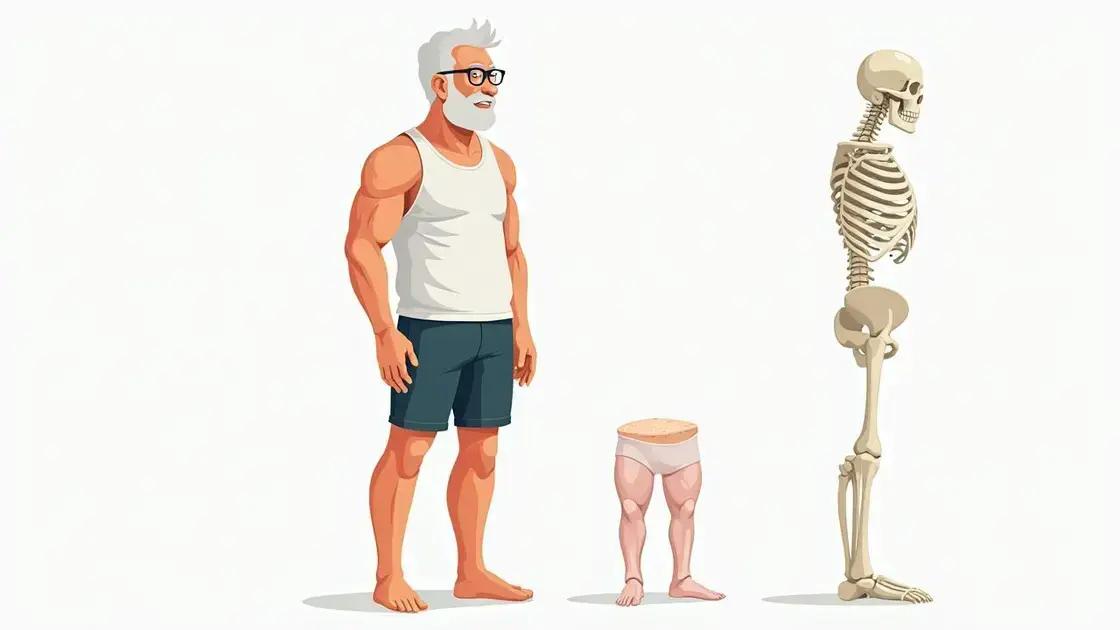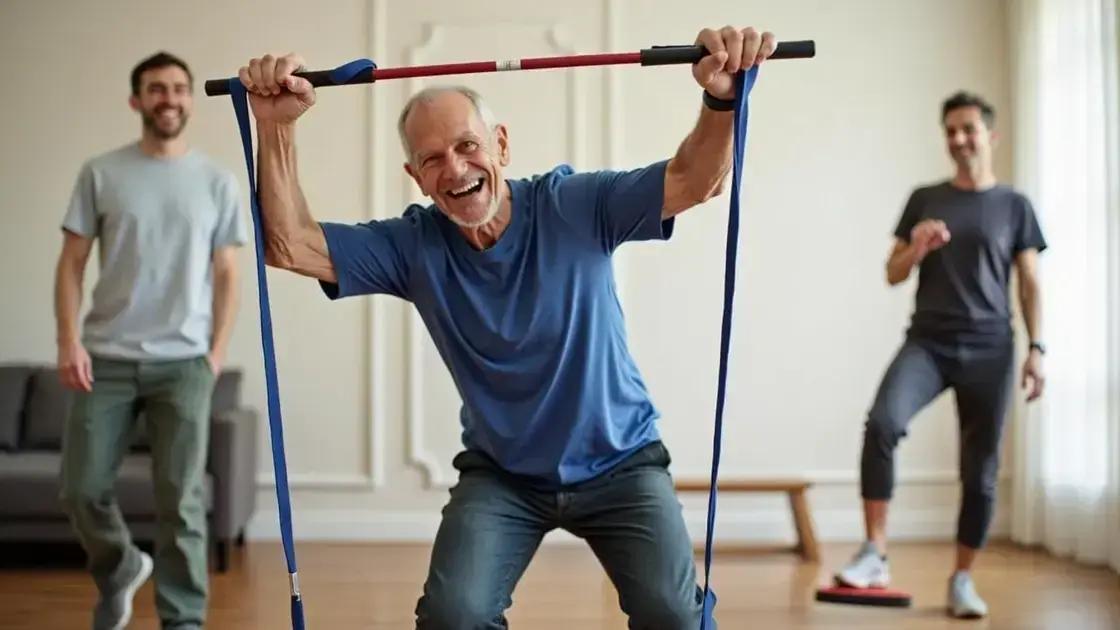High-Intensity Interval Training (HIIT) is evolving to meet the needs of men over 50, offering significant benefits such as improved cardiovascular health, weight management, increased muscle mass, and enhanced mental well-being through adaptable, low-impact workouts.
High-Intensity Interval Training (HIIT) is rapidly evolving, especially for men over 50. This innovative fitness approach caters to the unique needs of aging individuals, promoting their health and enhancing overall vitality. In this article, we will delve into the benefits of HIIT for older men, understand the changes in fitness as one ages, and explore how to adapt these workouts for better results. Additionally, we’ll share inspiring success stories that highlight the transformative power of HIIT.
The Benefits of HIIT for Men Over 50

High-Intensity Interval Training (HIIT) offers significant benefits for men over 50, promoting both physical and mental health. HIIT is adaptable, efficient, and effective. These workouts can fit into busy schedules while delivering impressive results.
Improves Cardiovascular Health
One of the main benefits of HIIT is its ability to boost cardiovascular health. Studies show that short bursts of intense activity improve heart and lung function. This is especially important for men over 50 as they may face increased health risks.
Promotes Weight Management
HIIT is also effective for weight management. The intense workouts burn more calories in a shorter amount of time compared to traditional workouts. Additionally, HIIT boosts the metabolism, helping to burn calories even after the workout.
Increases Strength and Muscle Mass
As men age, maintaining muscle mass becomes crucial. HIIT can incorporate strength exercises that help build muscle. Over time, this can lead to increased strength, improved balance, and better overall body composition.
Enhances Mental Health
Engaging in HIIT not only enhances physical fitness but also improves mood and reduces stress. The release of endorphins during high-intensity workouts can promote feelings of happiness and well-being, which is beneficial for mental health.
Finally, HIIT can lead to social interaction. Participating in group HIIT classes allows men over 50 to connect, share experiences, and encourage each other, fostering a sense of community.
Understanding Fitness Changes with Age

As men age, fitness changes significantly. Understanding these changes can help in creating an effective exercise plan. One common change is reduced muscle mass. Starting around age 30, men can lose 3-5% of muscle mass per decade. This can lead to weakness and a slower metabolism.
Decline in Bone Density
Another important aspect is bone density. With age, bones can become weaker and more fragile. This increases the risk of fractures. Weight-bearing exercises, such as HIIT, can help improve bone health by increasing density.
Changes in Flexibility
Flexibility often decreases with age. Muscles and tendons become less elastic, making movements stiffer and less fluid. Regular HIIT workouts, which include dynamic stretches, can improve flexibility and range of motion.
Cardiovascular Changes
Cardiovascular health is also affected by aging. Heart rate and blood flow can decline, making it important to incorporate aerobic exercises into fitness routines. HIIT can effectively boost cardiovascular health, helping to keep the heart strong.
Lastly, mental health should not be overlooked. As men age, maintaining mental sharpness becomes key. Exercise, especially high-intensity workouts, releases endorphins that can improve mood and cognitive function.
Adapting HIIT Workouts for Older Adults

Adapting HIIT workouts for older adults is essential to ensure safety and effectiveness. Many older adults can still enjoy high-intensity interval training, but modifications may be necessary.
Start with Low-Impact Movements
Instead of high-impact exercises, focus on low-impact alternatives. Movements such as cycling, swimming, or using an elliptical machine reduce joint strain while still elevating the heart rate. This makes HIIT more accessible.
Shorten Work Intervals
For older adults, it may be beneficial to shorten work intervals. Instead of 30 seconds of intense exercise, starting with 15-20 seconds can help. This allows for a more manageable effort while still providing the benefits of HIIT.
Incorporate Active Recovery
Adding active recovery periods is important. Give ample time between high-intensity intervals for complete recovery. Consider light walking or gentle stretching to help lower heart rates steadily.
Focus on Strength and Balance
Include strength and balance training in HIIT routines. Resistance exercises, like using light weights or resistance bands, can help maintain muscle mass and improve stability. This is crucial for reducing the risk of falls.
Lastly, consult with a healthcare provider before starting any new exercise program. This ensures that the routine is safe and tailored to individual health needs.
Success Stories: Transformations Through HIIT

Success stories of men over 50 transforming their health through High-Intensity Interval Training (HIIT) are inspirational. These individuals demonstrate how HIIT can lead to significant changes in fitness and well-being.
John’s Journey
At age 55, John struggled with weight and low energy levels. After starting a HIIT program, he lost 30 pounds and gained muscle mass. His doctor noted improved cardiovascular health, allowing John to participate in activities he once found difficult.
Mike’s Transformation
Mike, 62, had always enjoyed sports but found himself slowing down. He began a HIIT routine that included sprinting and cycling. Within months, Mike improved his endurance and strength. He now participates in local cycling events, feeling vibrant and youthful.
David’s Health Revival
After a health scare at 58, David committed to fitness. He embraced HIIT workouts that focused on low-impact exercises tailored for older adults. This change led to lower blood pressure and increased energy. David now encourages peers to stay active.
Community Impact
These stories reflect a larger movement. Many men over 50 are discovering the benefits of HIIT. Group classes have formed, creating a supportive environment. Participants motivate each other, sharing successes and challenges.
The physical and mental transformations seen in these stories highlight the power of HIIT for older adults. These experiences serve as a reminder that it is never too late to start prioritizing health.
Embracing HIIT: A Path to Health for Men Over 50
High-Intensity Interval Training (HIIT) offers transformative benefits for men over 50, facilitating significant improvements in fitness, strength, and overall well-being.
Understanding the physiological changes that occur with age allows for effective adaptations to HIIT, making it a safe and impactful workout choice. Success stories like those of John, Mike, and David highlight the positive changes that can be achieved through dedication and the right training approach.
By joining supportive communities and sharing experiences, older adults can stay motivated and empowered. As HIIT continues to evolve, it proves to be an essential tool for fostering a healthier lifestyle, enabling men over 50 to enhance their physical capabilities and quality of life.
FAQ – Frequently Asked Questions about HIIT for Men Over 50
What is High-Intensity Interval Training (HIIT)?
HIIT is a form of exercise that alternates between short bursts of intense activity and periods of rest or lower intensity. It’s effective for improving fitness in a short amount of time.
What are the benefits of HIIT for men over 50?
HIIT can improve cardiovascular health, promote weight management, increase strength and muscle mass, and enhance mental health.
Can older adults safely participate in HIIT?
Yes, with proper adaptations and modifications, older adults can safely participate in HIIT. It’s important to consult with a healthcare provider before starting any new exercise program.
How can HIIT be adapted for older adults?
HIIT for older adults can include low-impact exercises, shortened work intervals, active recovery periods, and a focus on strength and balance training.
What success stories exist for men over 50 using HIIT?
Many men over 50 have successfully transformed their health through HIIT. Their stories often include weight loss, increased energy levels, and improvements in overall fitness.
How often should men over 50 do HIIT workouts?
It’s generally recommended for men over 50 to engage in HIIT workouts 2-3 times a week, allowing for adequate recovery time between sessions.












